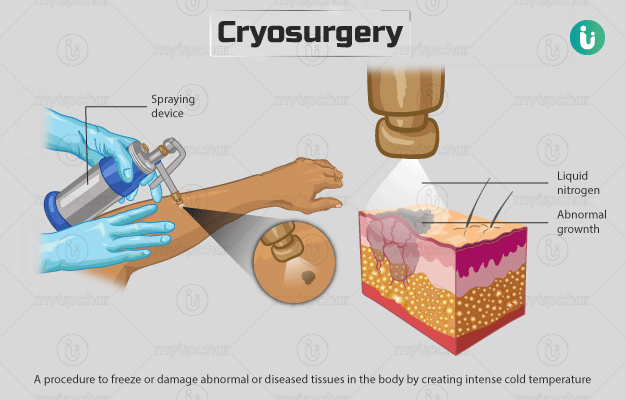Summary
Cryosurgery is a procedure to destroy abnormal growths on the skin and tumours inside the body using argon gas or liquid nitrogen.
A spraying device or cotton swab is used to apply the cold gas and treat abnormal growths outside the body while internal tumours are treated with an instrument called a probe, which is inserted through a small skin incision (percutaneous approach). The probe is guided towards the tumours using imaging techniques such as ultrasound and magnetic resonance imaging. Open surgery can also be used to treat internal tumours; however, this method requires a relatively larger incision. You will be able to go home on the same day of the surgery.
- What is cryosurgery?
- Why is cryosurgery recommended?
- Who can and cannot get cryosurgery?
- What preparations are needed before cryosurgery?
- How is cryosurgery done?
- How to care for yourself after cryosurgery?
- What are the possible complications/risks of cryosurgery?
- When to follow up with your doctor after cryosurgery?
What is cryosurgery?
Cryosurgery (cryoablation) is a procedure to freeze or damage abnormal or diseased tissues in the body by creating intense cold temperature.
Although this procedure was initially developed to treat tumours and abnormal tissues present outside the body, nowadays, it is being used to destroy tumours inside the body. However, cryosurgery can only treat tumours that are located at a single site and not spread to other tissues/organs. During the procedure, the diseased tissue is subjected to high-pressure argon gas or liquid nitrogen (cold gas) to freeze and destroy it. Extreme cold condition destroys the tissue by:
- Forming lethal ice crystals, at about -40oC, within the cells
- Forming ice in the fluid that is situated outside the cells, resulting in dehydration of the cells
- Draining water out of the cells, which leads to the shrinking of cells
- Causing expansion of ice within the cells, which bursts the cells
- Forming ice in the blood vessels that cut off the blood supply to the tissue
Why is cryosurgery recommended?
This surgery is recommended in individuals with the following conditions:
- Skin conditions such as:
- Retinoblastomas: Symptoms of retinoblastomas include:
- Liver cancer: Symptoms of the condition include:
- A lump in the abdomen
- Loss of appetite
- Fatigue
- Yellow colouration of skin and eyes
- Flu-like symptoms
- Cervical cancer: Symptoms of this condition include:
- Abnormal bleeding or discharge from the vagina
- Pain in the lower part of the trunk/torso
- Pain during sex
- Prostate cancer and tumours in the lungs, kidneys, breasts, and bones.
Who can and cannot get cryosurgery?
This surgery is not recommended in individuals with the following:
- Cryofibrinogenemia (the fibrinogens in the blood precipitate [form a gel] on exposure to cold)
- Raynaud disease
- Multiple myeloma
- Cryoglobulinemia (the immunoglobulins in the blood precipitate on exposure to cold)
- Agammaglobulinemia
- Cold urticaria
- Neoplasm (abnormal growth of tissue) of uncertain behaviour
- Poor circulation or a history of cold-related injury in the area of operation
- Primary liver tumour
What preparations are needed before cryosurgery?
You will need to visit the hospital a few days prior to the surgery for a preoperative assessment wherein you will be required to share the following details:
- Your medical history
- A history of allergies
- History of anaesthesia
- Pregnancy status
- A list of medicines that you take, including herbs, vitamins, and over-the-counter drugs
The doctor will order a few tests to make sure that you are an eligible candidate for the surgery. These include:
- Blood tests
- Urine tests
- Pregnancy test
In addition, you will be given the following instructions to prepare for the surgery:
- Discontinue warfarin, ibuprofen, aspirin, or other blood-thinning medications.
- If you are regular smoker, the surgeon will ask you to stop smoking.
- You will be asked to fast from the midnight prior to the surgery. Fasting is recommended to prevent vomiting (risk of general anaesthesia) during the surgery.
- Arrange for a friend, family member, or responsible adult to drive you home after the surgery.
- Inform the surgeon if you have flu, cold, or fever on the days leading to the surgery. In such a case, your surgery may be postponed.
- Take a shower and remove all the make-up, body piercings, and nail polish before you arrive at the hospital on the scheduled day of the surgery.
- You will have to sign a consent form if you agree to the procedure.
How is cryosurgery done?
After you arrive at the hospital, the hospital staff will give you a gown to change into. They may also insert an intravenous (IV) line in your arm to provide you with essential medicines and fluids during the surgery. If cryosurgery is performed to treat warts and other abnormal tissues outside the body, the procedure involves the following:
- The surgeon will administer local anaesthesia (numbing medicine) in the area to be operated and trim the wart or abnormal tissue using a small knife.
- He/she will spray liquid nitrogen or applied to the wart using a spray device or cotton swab to freeze the abnormal tissue.
- The surgeon will thaw the tissue and then cool it again. This cycle will be repeated two to three times.
- You may require multiple procedures to treat the condition with a gap of one to three weeks between each procedure.
The procedure involves the following steps if it is performed to destroy tumours within the body by percutaneous (through the skin) approach:
- You will be given a sedative through the IV route. In some cases, general anaesthesia (medicine given to make you fall asleep) is administered.
- The surgeon will shave and clean the area on your skin where the probe (a needle-like applicator) is to be inserted and then make a small incision (cut) on the area.
- He/she will insert the into the incision and advance it towards the tumours.
- The doctor will use imaging techniques such as ultrasound, magnetic resonance imaging (MRI), or computed tomography (CT) scan to guide the probe inside your body.
- Once the probe reaches the tumour, he/she will administer argon gas or liquid nitrogen to freeze the affected tissue and form an ice ball.
- After freezing, the surgeon will thaw the area, and this cycle will be repeated multiple times.
- The probe is then removed, and the doctor will use a bandage to cover the cut instead of stitching it.
Multiple probes will be inserted in the body to treat large tumours and certain other tumours. For example, about six to eight probes need to be inserted to treat prostate cancer. If cryosurgery is used to treat tumours in the cervix, the probe will be inserted through the vagina.
Your body temperature will be continuously monitored during and after the procedure as low body temperature is a side effect of cryosurgery. This procedure can also be conducted to remove internal tumours with an open surgical approach wherein a large incision is made. However, compared to the open surgery, the percutaneous approach requires a smaller cut and is associated with minimal trauma and damage to nearby healthy tissues.
The medical staff will remove the IV line after the surgery. The procedure is completed within one to three hours, and you will be able to go home on the same day. Cryosurgery helps to destroy internal localised tumours without the need to remove them. The destroyed tissue is naturally removed by the white blood cells.
How to care for yourself after cryosurgery?
You will be given specific instructions to care for the operated site before getting discharged from the hospital. If the surgery is performed to treat abnormal growths in the skin, a blister may form on the surgical area. You need to keep it protected with a dry, clean dressing. Apply an antiseptic cream if the blister bursts. The blister forms a crust that comes off after two to three weeks. Your doctor may prescribe painkillers and steroid ointments to treat any swelling that may develop in and around the operated area. It takes almost six weeks to completely heal after the procedure. The instructions to care for yourself after treatment for a tumour within the body may vary depending on the location of the tumour. You can resume your normal activities one to three days after percutaneous cryosurgery and seven to 10 days following open cryosurgery.
The procedure helps to get rid of the abnormal and precancerous growths from the skin and localised tumours inside the body.
When to see the doctor?
Contact the surgeon if you experience any of the following after the surgery :
- Fever
- Red streaks extending from the operated area to the skin
- Regrowth of abnormal tissue on the skin
- Severe swelling or pain that does not respond to medications
- Increased tenderness, redness, or warmth in the operated area
- Abnormal discharge from the wound
What are the possible complications/risks of cryosurgery?
The potential complications/risks associated with the procedure include:
- Infection
- Redness and swelling
- Blistering
- Pain
- Scarring
- Loss of sensation
- Skin discolouration
- Hard, rounded growths on the skin (keloid/hypertrophic scarring)
- Risks of general anaesthesia such as lung infection, heart attack, and confusion
When to follow up with your doctor after cryosurgery?
Your doctor will provide you with a schedule for follow-up appointments before discharging you from the hospital. You will undergo blood tests, a physical examination, and imaging tests during the follow-up visits to assess your healing.
Disclaimer: The above information is provided purely from an educational point of view and is in no way a substitute for medical advice by a qualified doctor.















